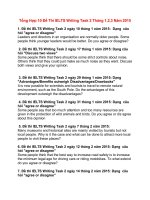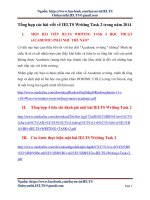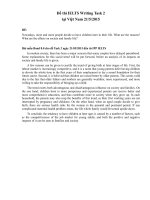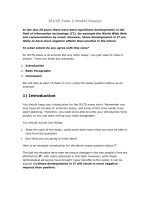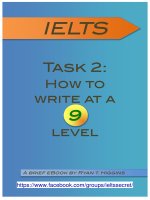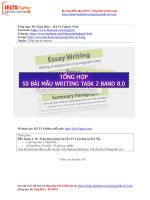IELTS writing task 2 ( Model essays and how to write them )
Bạn đang xem bản rút gọn của tài liệu. Xem và tải ngay bản đầy đủ của tài liệu tại đây (800.85 KB, 101 trang )
IELTS Writing Task 2:
Model essays and how to write them!
Mike Wattie
www.ieltsanswers.com
www.ieltsexaminer.com
© 2013 Mike Wattie All Rights Reserved
www.checkessay.com
Page 1
About the author
I have been teaching English as a second language for over fifteen
years in Taiwan and Australia, in language centres and universities.
I have also been working as an IELTS examiner. My area of
specialization is teaching students how to pass the IELTS exam. I
particularly enjoy teaching IELTS because I find it challenging to
teach students the necessary skills and strategies that they need to
pass, and I also find that my students are highly motivated – this is
a joy for a teacher!
Other books in this series
IELTS Task 1 Writing Academic Test
IELTS Task 1 Writing General Test
Acknowledgements
I would like to thank those responsible for their help in completing
this book. I sincerely thank Phil Biggerton for his time editing this
book. I would also like to thank some of my faithful students, Nhi
Phan, Andrey Polyakov, and Maria Gvozdeva, for providing valuable
feedback on this book. Thanks to all my past students as well, for
giving me the inspiration and desire to write this book.
Copyright
© Mike Wattie 2013
All Rights Reserved
No part of this book or any of its contents may be reproduced, copied, modified or adapted,
without the prior written consent of the author, unless otherwise indicated for stand-alone
materials.
© 2013 Mike Wattie All Rights Reserved
Page 2
Contents
1.
Overview ................................................................................................................... 6
1.1.
Sample question ..................................................................................................... 7
1.2.
The three biggest mistakes when taking the IELTS writing exam ............................. 8
1.3.
How to Improve ...................................................................................................... 9
1.4.
Task sequence for IELTS essay writing ................................................................... 10
2.
Grading of tasks ....................................................................................................... 12
3.
Comparing the three types of essays ........................................................................ 13
3.1.
4.
5.
Structuring the three types of essays .................................................................... 14
Parts of the essay .................................................................................................... 16
4.1.
Introduction .......................................................................................................... 16
4.2.
Body ..................................................................................................................... 19
4.3.
Conclusion ............................................................................................................ 21
4.4.
Planning your essays ............................................................................................. 23
Opinion essay .......................................................................................................... 25
5.1.
Typical question words ......................................................................................... 25
5.2.
Task Analysis ......................................................................................................... 26
5.3.
Planning your essay .............................................................................................. 27
5.4.
Steps in writing your essay .................................................................................... 29
5.5.
Model essay version 1: somewhat agree ............................................................... 34
5.6.
Template for opinion essay ................................................................................... 35
5.7.
Model essay version 2: totally agree ..................................................................... 36
5.8.
More sample questions of opinion essays ............................................................. 37
5.9.
Common mistakes ................................................................................................ 38
© 2013 Mike Wattie All Rights Reserved
Page 3
6.
Both sides and opinion essay ................................................................................... 40
6.1.
Typical question words ......................................................................................... 40
6.2.
Task analysis ......................................................................................................... 40
6.3.
Planning your essay .............................................................................................. 42
6.4.
Steps in writing your essay .................................................................................... 44
6.5.
Model essay 1: ...................................................................................................... 49
6.6.
Template for a both sides and opinion essay......................................................... 50
Model essay 2:................................................................................................................. 51
7.
8.
6.7.
More Sample Questions ........................................................................................ 52
6.8.
Common mistakes ................................................................................................ 54
Two question essay ................................................................................................. 56
7.1.
Sample question words ......................................................................................... 56
7.2.
Task analysis ......................................................................................................... 56
7.3.
Planning the essay ................................................................................................ 57
7.4.
Steps in writing your essay .................................................................................... 59
7.5.
Model essay one: .................................................................................................. 62
7.6.
Template for a two question essay........................................................................ 63
7.7.
Model essay two: .................................................................................................. 65
7.8.
More sample questions ......................................................................................... 66
7.9.
Common mistakes ................................................................................................ 66
Improving your score ............................................................................................... 67
8.1.
Common mistakes with task response .................................................................. 67
8.2.
Improving task response ....................................................................................... 71
8.3.
Common errors with cohesion and coherence ...................................................... 72
8.4.
Improving cohesion and coherence....................................................................... 74
8.5.
Common errors with vocabulary ........................................................................... 76
© 2013 Mike Wattie All Rights Reserved
Page 4
8.6.
Improving vocabulary ........................................................................................... 78
8.7.
Common errors with grammar .............................................................................. 79
8.8.
Improving grammar .............................................................................................. 80
8.9.
Reduce errors ....................................................................................................... 83
9.
Vocabulary for common topics ................................................................................ 87
9.1.
Education .............................................................................................................. 87
9.2.
Health ................................................................................................................... 90
9.3.
Media, .................................................................................................................. 92
9.4.
Technology ........................................................................................................... 94
9.5.
Crime .................................................................................................................... 96
9.6.
The environment .................................................................................................. 98
10.
Useful linking words and phrases ....................................................................... 100
© 2013 Mike Wattie All Rights Reserved
Page 5
1. Overview
Writing Task 2 is designed to test your ability to write an academic style essay. You must
present the information in your own words as complete sentences within paragraphs. You
are required to write over 250 words, and the task should be completed in about 40
minutes (both part 1 and 2 must be finished in 1 hour).
Types of Topics
There are many different topics for essays in the exam, but typical topic areas include:
education, crime, media, technology, social issues, technology and the future, and the
environment. In this case it makes sense to build up vocabulary in these key areas in order
to have sufficient language to write an essay well.
You can see the vocabulary pages of my website for ideas:
/>
Types of Questions
There are three main types of essay questions that are included in the IELTS writing exam. It
is important to learn how to structure each of these types. Each of these will be described
more fully in the sections that follow. Briefly, they are an opinion essay, where you are
asked to give your own personal opinion on a topic; a both sides and opinion essay, where
you are required to discuss both sides of an argument and then give your own personal
opinion on the topic; and a two question essay, which involves responding to two different
questions.
Tip!
Read the task carefully and make sure that you clearly understand
the topic and type of question before you start writing. This is
absolutely essential to score well in the writing test.
© 2013 Mike Wattie All Rights Reserved
Page 6
1.1. Sample question
WRITING TASK 2
How long you
should spend
You should spend about 40 minutes on this task.
Topic
Write about the following topic:
Some people believe that the fast pace and stress of
modern life is having a negative effect on families. Question
To what extent do you agree or disagree?
Give reasons for your answer and include any relevant examples from
your own knowledge or experience.
Write at least 250 words.
How many
words you
should write
Note that most of the parts of the task are standardised. For instance, you are always advised
to spend about 40 minutes on the task and you are always required to write at least 250
words. In addition you are always advised to include relevant examples from your own
knowledge or experience. Note that this is not a requirement, and you do not lose marks for
not giving examples. Giving examples is only one way of supporting your main ideas.
The only part that changes for each task is the part shown in larger letters in the box in the
middle of the task [see above]. This consists of a topic and a question. The topic tells you
what you need to write your essay about, and the question tells you what you must say about
the topic.
© 2013 Mike Wattie All Rights Reserved
Page 7
1.2. The three biggest mistakes when taking the IELTS writing exam
I have graded thousands of papers for the IELTS exam. The purpose of this article is to tell
you the three major mistakes that candidates keep making in order that you may avoid
them.
The first problem is poor time management. About 30% of my students who write IELTS
exams under timed conditions fail to complete both Task 1 and Task 2. In this case their
score for Task Response (one of the four grading criteria) is reduced, and to make matters
worse their score is penalized for being under length. Therefore, this is like a double penalty
and so you should make sure you can write sufficient words for both tasks by controlling
your time. This means 150 words for Task 1 and 250 words for Task 2.
The second problem is rushing to start the task without properly reading the question. Again,
also about 30% of my students will write an essay that is off-topic, which again not only
lowers their score for Task Response but also makes it difficult to score well in the grading
category of Cohesion and Coherence because often the essay does not make sense to the
reader who is looking for a response to the question. A common example of this is with a
question like “to what extent do you agree or disagree.” This requires YOUR opinion, and
therefore saying things like “some people believe that….” is off-topic, unless you state
whether you agree with them or not.
The final issue is the frequency of errors. Try to allow time to proofread what you have
written. In order to get above a six for vocabulary you may only produce occasional errors in
word choice, spelling and word formation. The biggest error is the singular/plural form of
words, so always check your nouns and verbs to see if they should have an “s” ending. For a
grammar score of 7 you must produce frequent error-free sentences. The most common
errors are with articles (a, an, the), so look at each noun and think about whether it needs
an article. In other words if you can proofread your writing and cut-down the number of
errors you stand a better chance of getting over the 6 hurdle for vocabulary and grammar.
© 2013 Mike Wattie All Rights Reserved
Page 8
1.3. How to Improve
In order to improve and score well in the exam I recommend you focus on the following
aspects:
1. Learn how the test is structured and graded
2. Learn skills to improve your answers
3. Practice skills
4. Do lots of practice tests. If you want to have your essay assessed by an experienced
examiner and tutor visit this page: />5. Receive feedback on practice tests
6. Use the feedback to improve your answers
© 2013 Mike Wattie All Rights Reserved
Page 9
1.4. Task sequence for IELTS essay writing
In order to complete your essay effectively and efficiently within the set time and conditions
of an IELTS exam you need to have a very clear and systematic approach to writing your
essays. From my experience as an examiner and teacher I recommend the following
approach. You may wish to modify this a little for your own personal style.
1. Read the Task.
This is a critical step that is often underestimated. Missing a single word in the instructions
might result in an essay that doesn't focus on the topic. For instance if the topic is about
young people and you only write about people in general then you will have a weak score
for task response. I also suggest you underline key words. This will help you to focus on
them and will also assist with the next step.
2. Rephrase keywords in the task instructions.
You need to rephrase the keywords that are given in the topic for two reasons. The main
reason is because if you do not, the examiner will put brackets around the words you have
copied from the task and these words will not be included in your word count. This may lead
to your essay being under length. As well as this, you should rephrase the keywords to show
your talent with vocabulary.
3. Establish the topic and the question type (there are three different types of questions).
You must focus on the topic and question to score well for task response.
4. Plan the structure of the answer
A good plan helps you to reduce the amount of time you need to write your essay and also
leads to a suitable structure. If you structure your essay well you will score well for cohesion
and coherence. As well as this it will be easier for the examiner to see the quality of your
task response.
© 2013 Mike Wattie All Rights Reserved
Page 10
5. Write your answer
If you have made a solid plan then the writing stage will go more quickly and smoothly.
Make sure you stick to your plan while writing. Also, do not think of additional points for
your essay while writing. Instead, utilise all of your brainpower on writing correct sentences
using correct language, so that you will have an essay that will score well for vocabulary and
grammar.
6. Proofread your answer if time permits
If you have any time at all left at the end of your exam, you should use it to proofread your
essay, so that you will have fewer errors with vocabulary and grammar. Focus on looking for
the common mistakes you make with your writing. Common ones are errors with subject
verb agreement, articles [a, an, the], and the “s” endings of words.
Tip!
Making a plan saves you time when you write your report
and ensures you cover all the key points using an
appropriate structure.
© 2013 Mike Wattie All Rights Reserved
Page 11
2. Grading of tasks
Criteria
Task Response
This criterion assesses how well
you have focused on the topic
and answered the question.
Coherence and Cohesion
This criterion assesses how well
you have structured your essay,
used paragraphing, and
connected your ideas.
Lexical Resource
This criterion assesses your
vocabulary in terms of errors and
also ability to use more advanced
language.
Grammatical Range and
Accuracy
This criterion assesses your
grammar in terms of errors and
also ability to use more advanced
sentence structures.
© 2013 Mike Wattie All Rights Reserved
Requirement
write over 250 words
satisfy all the requirements of the task
cover all parts of the topic
cover all parts of the question
develop main points
sequence information and ideas logically
use a range of cohesive devices appropriately
use paragraphing appropriately
Have a clear progression throughout
avoid unnecessary repetition of information
use of vocabulary to allow some flexibility and
precision
use less common vocabulary
awareness of style and collocation
avoid errors with word choices
avoid errors with word formation
avoid errors with spelling
uses a mix of simple and complex sentence forms
produce error-free sentences
avoid errors with grammar and punctuation
Page 12
3. Comparing the three types of essays
Key question words
Opinion
What is your opinion?
Both sides + opinion
Discuss the advantages and
disadvantages
Do you agree or disagree?
To what extent do you agree or
disagree?
Do you think the advantages
outweigh the disadvantages?
Discuss the advantages and
disadvantages and give your own
opinion
Discuss both sides of this
argument and then give your own
opinion.
Two question Essay
What problem does this cause?
What are some potential
solutions?
Do you agree?
What are some other solutions?
What are the causes of this
problem?
What are some potential
solutions?
Example question
Opinion
Both sides + opinion
Computers are being used more
and more in education and some
say there will soon be no role for
the teacher in education.
Computers are being used more
and more in education. Some
people say that this is a positive
trend, while others argue that it is
leading to negative consequences.
To what extent do you agree or
disagree?
Discuss both sides of this
argument and then give your own
opinion.
© 2013 Mike Wattie All Rights Reserved
Two question Essay
Alcohol abuse is becoming more
and more common in many
countries.
What are some of the problems it
causes?
What are some of the possible
solutions?
Page 13
Structuring the three types of essays
3.1.
Introduction
Opinion
Rephrase question
Position = state whether you agree
or disagree and the extent (how
much):
Both sides + opinion
Rephrase question
"This essay discusses…"+
[both sides] and [opinion]
Two question Essay
Rephrase question
"This essay discusses…" +
[question 1] and [question 2]
Body
Opinion
Both sides + opinion
Two question Essay
reason 1
Side 1 advantages
question 1
reason 2
Side 2 advantages
question 2
reason 3/concession (argument
against your main opinion)
[Note: keep your opinion out of
the body. It is only about what
people in general may think.]
Final paragraph
Opinion
Restating of your position +
summary of reasons
Both sides + opinion
Your Opinion
Two question Essay
Summary of question 1 and 2
State that both sides are
important/have merits
State which one is more
important/better
© 2013 Mike Wattie All Rights Reserved
Page 14
Essay Structure
Body
Topic sentence (Topic + Point)
Supporting sentence
Supporting sentence
Supporting sentence
Introduction
General Statement
Specific Statement
1
Topic sentence (Topic + Point)
Supporting sentence
Supporting sentence
Supporting sentence
Conclusion
2
Summary of
main points
Final Statement
[An opinion essay may have a
third paragraph]
Point 1 above:
The diagram above shows how the last part of the introduction functions to influence the
main points of each body paragraph. These main points are usually given in the topic
sentence.
Point 2 above:
The diagram shows how the main points from the body get summarised in the conclusion of
the essay
© 2013 Mike Wattie All Rights Reserved
Page 15
4. Parts of the essay
Further discussion is provided below on the structure of the essay, using the task below as
an example:
TOPIC:
Computers are being used more and more in education and some say there will
soon be no role for the teacher in education.
QUESTION:
To what extent do you agree or disagree?
4.1. Introduction
You only need two sentences for your introduction. You may have learnt from other
teachers that you should include aspects such as a background to the situation, but you
need to bear in mind that this is a very short essay of only a little over 250 words and so you
want to keep your introduction brief. I suggest you just write a general statement and
specific statement as explained below.
General statement
The general statement is the topic that you need to write about. You can write this very
easily by just rephrasing the topic you are given. This is the best way to do this. Do not try to
be creative here, as you will not be rewarded for this and you risk lowering your score for
task response if you misstate the topic: with reference to the topic above:
Computers are being used more and more in education and
some say there will soon be no role for the teacher in
education.
GOOD REPHRASE: Some people believe technology may be used to replace teachers in the
future.
© 2013 Mike Wattie All Rights Reserved
Page 16
BAD REPHRASE: Due to the rising prevalence of advanced technology computers are
becoming more useful. This misstates the topic because it is not about whether computers
are useful it is about whether they will replace teachers.
Too long a rephrase: Ever since the dawn of time, mankind has been finding ways to improve
their lives. More recently education has emerged as a very important aspect of human lives.
Therefore it is worthwhile to consider whether technology offers any advantages in the
classroom and whether they are more useful than the people who have trained for many
years as academic experts. Too long! It is like a history lesson, and this also makes the topic
a little unclear. If the writing is less clear then coherence is lowered. My key point here is
that big long introductions do more harm than good. In addition, it is better to spend more
time on the body of the essay, in order to show your ability to develop your main ideas
which increase your score for task response.
Specific statement
The specific statement comes from the question part of the task. What you write will
depend upon which of the three types of questions are asked. If the essay asks for your
opinion you should give this here. If the question asks for anything else you should start this
statement with this essay discussing and then rephrasing what you are asked for. Both of
these approaches are explained further below.
Specific Statement for an opinion essay
QUESTION: To what extent do you agree or disagree?
This type of question needs to be responded to very precisely in the introduction. You need
to have made a plan for your essay and have a clear idea of what your opinion is. To fully
respond to all words in the question you need to mention the EXTENT or how much you
agree or disagree. Some choices are:
Totally agree
Somewhat agree
Equally agree and disagree [this is a risky choice that I think should be avoided]
Somewhat disagree
Totally disagree
© 2013 Mike Wattie All Rights Reserved
Page 17
So the sentence will look something like:
I totally agree with this opinion [good and safe choice]
I totally agree that teachers should be replaced with computers [better as there is a fuller
sentence]
I totally agree that teachers should be replaced with computers because they are cheaper
and more convenient for students [best because it gives the examiner a clear idea of what
the essay is about. Paragraph 2 should be about cheaper, and paragraph 3 should be about
being more convenient].
Specific Statement for a non-opinion essay = "this essay discusses" + rephrase of the
question
QUESTION: Discuss the advantages and disadvantages of using computers in the classroom.
This essay discusses the merits and drawbacks of the use of computers in schools.
QUESTION: What are some disadvantages of using computers in the classroom? What are
some ways to overcome these disadvantages?
This essay discusses drawbacks with the use of computers in schools and also some ways to
solve them.
© 2013 Mike Wattie All Rights Reserved
Page 18
4.2. Body
The body of the essay should logically fit with the introduction you gave for the essay. The
specific statement [last sentence of the introduction] should serve as a guide for the body of
the essay. For instance, if you said you totally agree in the introduction then the body
should consist of two or three paragraphs about why you agree. If you said you somewhat
agree then the body should be mostly about why you agree, but also have a concession,
which means that you are pointing out some arguments from the opposing side of your
main opinion. The body of an IELTS essay should usually consist of two or three paragraphs.
You need to have logical paragraphing to score well for cohesion and coherence.
Structure of the body of an essay
Opinion essay
Both sides and opinion
Two question essay
Reason 1 for opinion
Side A
Question 1
Reason 2 for opinion
Side B
Question 2
Reason 3 for opinion
[optional]
[Opinion is given in the
concluding paragraph ]
The structure of each paragraph needs to be logical and there should be ONE clear focus for
each paragraph. The best way to achieve a clear focus and to communicate this to the
examiner is by making this clear in the first sentence of each paragraph. This first sentence is
called the topic sentence. Topic sentences usually have two key parts, which are the topic of
the essay and the key point that this paragraph will discuss about this topic.
Topic sentence = topic + key point about the topic
Some examples of topic sentences relating to the previous task: QUESTION: Discuss the
advantages and disadvantages of using computers in the classroom.
There are several merits of the use of computers in schools.
topic = use of computers in schools
key point about the topic = merits
© 2013 Mike Wattie All Rights Reserved
Page 19
However, there are some important drawbacks with using computers in education.
topic = using computers in education
key point about the topic = drawbacks
The first sentence of each paragraph, often referred to as a topic sentence, introduces the
paragraph by stating and summarising the main point being made in the paragraph. Topic
sentences often contain transition signals, which aid in the smooth transition from one
paragraph to the next. This first sentence should inform the reader of the point you are
making and how this paragraph relates to the question. In fact, if the reader were to scan
your topic sentences, they should be able to obtain a sketch of the entire essay. This sketch
should show the logical progression of the points you are making. The absence of topic
sentences leaves the reader wondering what you are trying to say and why, ultimately
confusing the reader. Signposting is not limited to topic sentences. Signposting within your
paragraph also aids the reader. The following example illustrates the effective use of
signposts (signposts are underlined).
Finally, as with all models of learning, rote memorisation has limitations. For example, the
model implies that learning occurs in a serial processing form, whereas we know that
learning is a recursive process. Furthermore, the model fails to take into account motivation,
and social interaction as essential aspects of the learning process. Nevertheless, the model
gives educators many useful guidelines for considering how information can be structured to
facilitate learning.
Effective paragraphs have three important qualities.
UNITY: A paragraph should focus on one main idea.
DEVELOPMENT: this occurs when the idea is elaborated on in the paragraph. This
elaboration usually consists of explaining the key point adding details about it or giving an
example to illustrate it.
COHERENCE: This means everything in the paragraph should relate to and expand on the
point you are making.
© 2013 Mike Wattie All Rights Reserved
Page 20
4.3. Conclusion
Given that an IELTS essay is only a little over 250 words and you have limited time to write
your essay. It is important that you can write a brief but complete conclusion to your essay.
You need to send a SIGNAL to the examiner that you are making the conclusion to your
essay. I like the phrase in conclusion best. I suggest you just use this as it can be used for ALL
THREE types of essays. The more you can avoid the need to have to remember and correctly
apply different phrases for each type of essay the better. I really hate in a nutshell. I think
other people may hate this, so I don’t recommend it. It is not impressive; I feel it is a cliché,
or an overused phrase. I also don’t feel it is formal. If you say in summary or to summarise
my main points you will have to not use these phrases with certain types of essays. For
instance, with a both sides and opinion essay you are not really summarising your main
points in the final paragraph, you are giving your own opinion.
After the signal we have to apply two different structures depending on the type of essay.
We can separate these into two types, an opinion for a both sides and opinion essay and a
summary for an opinion essay or two question essay.
© 2013 Mike Wattie All Rights Reserved
Page 21
Conclusion for each type of essay
Opinion essay
1. Restate whether you agree
or disagree and also the
extent. If your position is
somewhat agree/disagree
then make sure you put the
side you support most first.
Both sides and opinion essay
1. State that both sides of the
argument are important/have
merits
2. Summarise the main
reasons for your opinion
[summarise the main reasons
from the body of your
essay].
3. Say why. Justify your
selection. This is the key to
reaching grade 7 and above
for task response. Remember
that YOUR opinion is one of
the three parts of the question
and although this paragraph
may be briefer than the body
paragraphs it is a very
important one.
3. Say something more.
Ideally if you still have time
try to write one more
sentence to give a final
opinion or recommendation
based on your summary.
This is the difference
between a good conclusion
and an excellent one!
In conclusion, I totally
disagree that machines can
replace teachers. This is
because teachers can
encourage students to learn
and teach them how to
interact with other people.
2. State which one is more
important/better
In conclusion, I believe both
sides of the argument have
their merits. On balance,
however, I tend to believe that
the advantages of studying
using a computer outweigh
those made possible by a
teacher. This is because it is
cheaper and more convenient
to study online.
© 2013 Mike Wattie All Rights Reserved
Two question essay
1. Summarise the main
points of question 1
2. Summarise the main
points of question 2.
In conclusion, the main
problems with using
computers in schools are
that students get distracted
from studying and they use
them to access
inappropriate content. These
can be overcome by
educators monitoring their
students closely and by
restricting the websites they
can access.
Page 22
4.4. Planning your essays
On a few occasions I have been an invigilator (person to make sure no one is cheating!) in
the writing exam. I was amazed to see that about 10% just started writing their essays
without writing any plan first. Afterwards, I asked some of my students who were attending
why they didn’t write a plan. “Oh we thought we didn’t have time to do it.”
The plan serves three purposes. First, it helps you think about the main points you will write,
so it increases your score for Task Response. Second, it helps you structure your essay
better, so it increases your score for Cohesion and Coherence. Finally, it saves you time.
That’s right! By making a plan first, you won’t have to keep stopping to think what you will
write next.
Each essay question is composed of two parts. The TOPIC, which is what the essay is about;
and the TASK, which is what sort of essay you need to write. There are three main types of
essays. The first asks your opinion, or do you agree or disagree. The second asks you to
explain two sides of an argument and then give your own personal opinion on that topic.
The third asks you two questions; for example, “discuss the problems and solutions.”
You should learn how to plan for all three types of essays. You can practice your planning by
looking at past exam questions and thinking what would be your main points and how
would you structure the essay. If you need someone to correct your essays and give
feedback on how to improve checkout my service at: />
© 2013 Mike Wattie All Rights Reserved
Page 23
Tasks that include examples
If the task mentions "for instance" or "for example", that means you don't have to
specifically mention those items. So you don't have to talk about sport or music you could
talk about art instead
It is generally believed that some people are born with certain talents, for instance for sport
or music, and others are not. However, it is sometimes claimed that any child can be taught
to become a good sports person or musician.
Discuss both these views and give your own opinion.
Tasks that include two parts [usually signalled by "and"]
For the task below, the topic includes two parts and both must be referred to in the body of
the essay. These two parts are cheaper and easier. You need to include both to get to 6 for
task response and you need to cover both of them well to get to 7 and above.
These days, due to advances in technology, it is cheaper and easier to travel abroad.
Do the advantages outweigh the disadvantages?
© 2013 Mike Wattie All Rights Reserved
Page 24
5. Opinion essay
This type of essay tests your ability to state an opinion on an issue and then support it with
logical reasons. To score well you need to explain your reasons clearly and use examples to
illustrate the key points you are trying to make.
5.1. Typical question words
What is your opinion?
Do you agree or disagree?
To what extent do you agree or disagree?
Do the advantages outweigh the disadvantages?
To what extent do the advantages outweigh the disadvantages?
Sample task
Some people believe that the fast pace and stress of modern life is having a
negative effect on families.
To what extent do you agree or disagree?
© 2013 Mike Wattie All Rights Reserved
Page 25
